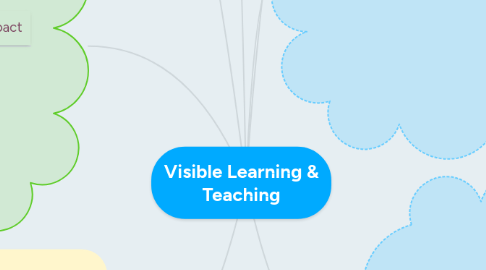Visible Learning & Teaching
by Breanna Sackrey

1. The Claim of Positive Effect
1.1. Almost all intervention strategies have a positive effect on student learning.
1.2. Not all intervention strategies are created equal.
1.3. An effect of .40 is average.
1.4. Because almost all intervention has a positive effect on education almost any intervention can be labeled as effective.
1.5. Effectiveness should not be based on a 0.0 scale.
2. Schooling Should Impact
2.1. The student's knowledge and understanding.
2.2. The student's capacity to see the world from different view points.
2.3. The student's ability to understand human weaknesses and injustices.
2.4. The student's ability to cooperate and working with others
2.5. The student's genuine concern for self and others.
2.6. The student's accountability and personal responsibility.
2.7. The student's critical thinking and dissenting voice.
3. The Expert Teacher
3.1. Can identify the most important ways in which to represent the subject they teach.
3.2. Is proficient at creating an optimal classroom climate for learning.
3.3. Monitors learning and provides feedback.
3.4. Believes that all students can reach the success criteria.
3.5. Influence surface and deep student outcomes.
4. References
4.1. Terhart, E. (2011). Has john hattie really found the holy grail of research on teaching?: an extended review of "visible learning". Journal Of Curriculum Studies, 43(3), 425-438.
4.2. Hattie, J. (2012). Visible learning for teachers: Maximizing impact on learning. New York: Routledge.
5. Visible Learning and Teaching Occurs When
5.1. Learning is the explicit and transparent goal.
5.2. When it is appropriately challenging
5.3. When the teacher and the student seek to ascertain whether and to what degree the challenging goal is attained.
5.4. Deliberate practice aimed at attaining mastery of the goal.
5.5. When there is feedback given and sought.
5.6. When there are active, passionate, and engaging people participating in the act of learning.
6. When Student Become their own Teachers
6.1. The exhibit self-regulatory attributes
6.2. Self-monitoring
6.3. Self-evaluation
6.4. Self-assessment
6.5. Self-teaching
7. What is The Teacher's Role?
7.1. To see themselves as evaluators of their effects on students.
7.2. To use evidence-based methods to inform, change, and sustain evaluations of their beliefs about their effect.
7.3. To have an appropriate mind frame relating to the impact of what they do.
7.4. To evaluate their effect on learning.
7.5. Deliberate interventions to ensure that there is cognitive change in the student.
7.6. To be vigilant to what is working and what is not working in the classroom.


